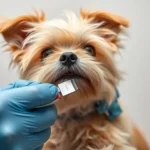
Dog health care is a crucial aspect of responsible pet ownership, encompassing everything from regular check-ups to understanding the anatomy and health needs of your furry friend. Just like humans, dogs can experience a variety of health concerns that require attention and expertise. One often-overlooked area that plays a significant role in a dog’s health is their anatomy, particularly the number of nipples a dog has and their implications for overall health.
Understanding Dog Anatomy
Basic Anatomical Features
Understanding dog anatomy is essential for any dog owner. Dogs are complex creatures with various anatomical features that support their health and well-being. A dog’s body is designed for agility, strength, and endurance, but certain conditions can affect their health.
The skeletal system, muscular structure, and organ systems all work together to keep your dog healthy. Knowledge of these systems allows owners to recognize when something is amiss, enabling them to seek veterinary care promptly.
Reproductive Anatomy
Dogs have distinct male and female reproductive anatomies. Male dogs possess testicles and a penis, while female dogs have a uterus, ovaries, and, notably, nipples. The nipples in female dogs serve a significant purpose, especially during pregnancy and nursing. They provide a means for puppies to nurse, delivering essential nutrients for their growth and development.
Understanding the reproductive anatomy of your dog is vital, not just for breeding purposes but also for recognizing potential health issues related to their reproductive system.
How Many Nipples Does a Dog Have?
Typical Number of Nipples
A common question among dog owners is, how many nipples does a dog have? Typically, dogs have between 8 to 12 nipples, though this number can vary among different breeds. Some smaller breeds may have fewer, while larger breeds might have more. The distribution of these nipples is usually symmetrical, with four on each side of the belly.
Functional Purpose of Nipples
Nipples play a crucial role in the reproductive cycle of female dogs. They are designed to provide milk to nursing puppies. The presence and health of nipples can be indicators of a dog’s reproductive health, and any changes or abnormalities should be monitored closely.
For example, if a female dog experiences swelling or discharge from her nipples when not nursing, it could indicate health issues that require veterinary attention.
Importance of Regular Health Checks
Physical Examination
Regular health checks are vital for maintaining your dog’s overall health. During a routine examination, pet owners should pay particular attention to the nipples, checking for any abnormalities such as lumps, bumps, swelling, or unusual discharge. These could be signs of underlying health issues that require further investigation.
In addition to monitoring nipple health, a comprehensive physical exam will include checking your dog’s weight, coat condition, dental health, and overall body condition.
When to Seek Veterinary Attention
As a responsible dog owner, knowing when to seek veterinary attention is crucial. Signs that indicate potential health issues related to the nipples include:
- Swelling or redness
- Unusual discharge (especially if it’s bloody or pus-like)
- Lumps or tumors present
- Changes in appetite or behavior
Additionally, consider other health concerns that can arise in relation to the reproductive system, such as pyometra (a serious uterine infection) or hormonal imbalances.
Common Health Issues Related to Nipples
Mastitis
Mastitis is a condition that can affect nursing dogs. It occurs when the mammary glands become inflamed, usually due to bacterial infection. This can happen if puppies do not nurse adequately or if milk is retained in the glands.
Symptoms of mastitis include:
- Swollen and painful nipples
- Redness in the mammary area
- Fever and lethargy in the mother
- Discharge from the nipples
Treatment typically involves veterinary intervention, which may include antibiotics and supportive care to help manage the condition and keep the mother comfortable.
Tumors and Cysts
Another concern related to the nipples is the development of tumors or cysts. These can be benign or malignant, and recognizing the signs early can make a significant difference in treatment outcomes.
Signs to watch for include:
- Lumps or bumps on or near the nipples
- Changes in nipple appearance (shape, size, or color)
- Discharge that is not associated with nursing
If any of these signs are noted, a veterinary examination is essential. Diagnostic procedures may include fine-needle aspiration or biopsy to determine the nature of the growth.
Nutrition and Its Impact on Dog Health
Importance of a Balanced Diet
A well-balanced diet is integral to maintaining your dog’s overall health, including skin and coat condition, energy levels, and reproductive health. Nutritional needs can vary based on age, breed, and health status.
Key nutrients that support reproductive health include:
- Protein: Essential for tissue repair and growth
- Omega-3 and Omega-6 fatty acids: Important for skin health and reducing inflammation
- Vitamins and minerals: Crucial for immune function and overall wellness
Supplements for Optimal Health
In some cases, dogs may benefit from supplements, particularly during pregnancy or nursing. Supplements like DHA (Docosahexaenoic Acid) can support brain development in puppies, while calcium and phosphorus are vital for bone health.
Consulting with a veterinarian about your dog’s dietary needs and any potential supplementation is always a good idea, especially if your dog is pregnant, nursing, or experiencing health issues.
Preventive Care for Dogs
Vaccinations and Regular Check-Ups
Preventive care is a cornerstone of dog health care. Vaccinations play a critical role in protecting dogs from various diseases, while regular check-ups help monitor health and catch potential issues early.
Most veterinarians recommend annual wellness exams, but some dogs may require more frequent visits based on their health status or age. These visits are an excellent opportunity for pet owners to discuss any concerns, including those related to nipple health or reproductive issues.
Spaying and Neutering
Spaying and neutering can have numerous health benefits for dogs. For female dogs, spaying eliminates the risk of certain reproductive health issues, including pyometra and some types of cancer. Additionally, spaying can help regulate hormone levels, potentially reducing the risk of mammary tumors.
In contrast, neutering male dogs can prevent testicular cancer and reduce behavior related to mating instincts. Understanding these benefits can help dog owners make informed decisions about their pets’ reproductive health.
Grooming and Hygiene
Regular Grooming Practices
Regular grooming is more than just maintaining a dog’s appearance; it significantly contributes to their skin and coat health. Grooming removes dirt, dander, and loose hair, which can prevent skin infections and promote a healthy coat.
For nursing dogs, special attention to grooming is crucial. Frequent brushing can help reduce the risk of matting and skin irritation, particularly around the nipple area.
Maintaining Cleanliness in Reproductive Areas
Keeping the nipple area clean is vital for preventing infections. Regular baths and gentle cleaning with a damp cloth can help maintain hygiene. It’s also essential to monitor for any changes or issues in the nipple area, such as swelling or unusual discharge, which can indicate health concerns.
Conclusion
Understanding your dog’s anatomy, particularly aspects like the number of nipples a dog has, is essential for effective health care. Nipples play a significant role in a dog’s reproductive system, and monitoring their condition can help identify potential health issues early.
By prioritizing regular health checks, maintaining a balanced diet, and practicing good hygiene, dog owners can significantly enhance their pets’ overall health and well-being. Always consult a veterinarian for personalized care plans tailored to your dog’s unique needs.









